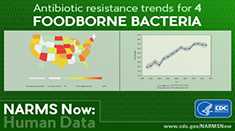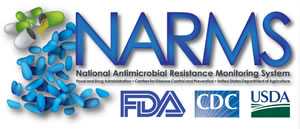NARMS 2014 Human Isolates Surveillance Report
CDC NARMS tracks antimicrobial resistance in Salmonella and other intestinal (enteric) bacteria that may cause mild or severe diarrhea or bloodstream infection. NARMS is an interagency partnership among the U.S. Centers for Disease Control and Prevention (CDC), the U.S. Food and Drug Administration (FDA), the U.S. Department of Agriculture (USDA), and state and local health departments.
Bacterial foodborne infections are common and can sometimes be serious. In severe cases, the right antibiotic, also called antimicrobial agent, can be life-saving. Some antibiotics don’t work because the foodborne pathogen has become resistant. NARMS is the only source of national information on antibiotic resistance in foodborne pathogens like Salmonella. Understanding trends in antibiotic resistance helps doctors to prescribe effective treatment and public health officials to investigate outbreaks faster.
 The NARMS 2014 Human Isolates Report [PDF – 83 pages, 1.88 MB] provides the most recent nationwide data on antibiotic resistance transmitted commonly by food, including:
The NARMS 2014 Human Isolates Report [PDF – 83 pages, 1.88 MB] provides the most recent nationwide data on antibiotic resistance transmitted commonly by food, including:
- Salmonella
- Shigella
- Campylobacter
- E. coli O157
- Vibrio species other than Vibrio cholerae
Report Highlights
Whole Genome Sequencing of Salmonella
For the first time, the NARMS annual report includes whole genome sequencing (WGS) data of bacteria from people with antibiotic-resistant Salmonella infections. Genetic data provided by this sequencing can be used to identify resistance genes and predict antimicrobial resistance.
- Read more about this analysis and its results
- Download isolate-level data from NARMS Now: Human Data
Key Trends
To determine trends, NARMS compared the prevalence of antibiotic resistance in 2014 with the average prevalence from two reference periods: 2004–2008 and the previous five years, 2009–2013. The 2004–2008 reference period begins with the second year that all 50 states participated in Salmonella and Shigella surveillance and all 10 FoodNet sites participated in NARMS Campylobacter surveillance. The additional 2009–2013 reference period allows comparison with more recent years. Some trends were encouraging; others were concerning.
Encouraging
- Multidrug resistance in Salmonella was similar to the previous year and has remained stable over the past 10 years:
- 2014: 9.3%
- 2009–2013: 9%
- 2004–2008: 11%
- Resistance to ceftriaxone in Salmonella remained rare, but notable:
- 2014: 2%
- 2004–2008 and 2009–2013: 3%
- Resistance to certain groups of antibiotics in Salmonella Typhimurium (ACSSuT) and Salmonella Newport (ACSSuTAuCx) remained lower in 2014 compared with 2004–2008.
- No Salmonella isolates had decreased susceptibility to both azithromycin and ciprofloxacin, and none had both decreased susceptibility to azithromycin and resistance to ceftriaxone, which are important drugs for the treatment of severe Salmonella infections.
Concerning
- Multidrug resistance in a common Salmonella serotype (l 4,[5],12:i:-) continued to be greater than 40%.
- Resistance more than doubled since 2011 (18% in 2011 vs. 43% in 2014) and has been linked to animal exposure and eating pork or beef, including meat purchased from live animal markets.
- Six of the 51 ceftriaxone-resistant Salmonella in 2014 had an extended-spectrum β-lactamase (ESBL) gene identified by WGS.
- ESBLs are rare among Salmonella in the United States. Many of these infections are acquired during international travel.
-
Salmonella serotypes Dublin, Heidelberg, Newport, and Typhimurium accounted for nearly two-thirds of isolates resistant to ceftriaxone
- 60% of serotype Dublin isolates were resistant to ceftriaxone.
- Decreased susceptibility to ciprofloxacin in Salmonella was higher in 2014 (4%) than in the baseline period of 2004–2008 (2%) and in 2009–2013 (3%)
- 8% of Salmonella Enteritidis (the most common Salmonella serotype) had decreased susceptibility to ciprofloxacin, accounting for 38% of all ciprofloxacin-resistant Salmonella isolates
-
Salmonella Typhi (the bacteria that cause typhoid fever) also showed higher levels of decreased susceptibility to ciprofloxacin:
- 2014: 74%
- 2009–2013: 68%
- 2004–2008: 53%
-
Campylobacter resistance to fluoroquinolones remained high, at times leaving macrolides as the only treatment option.
- Ciprofloxacin resistance in Campylobacter jejuni, the most common species isolated from humans, increased from 22% in 2013 to 27% in 2014. Resistance in Campylobacter coli was 35%, similar to recent years.
- Macrolide resistance decreased from 18% in 2013 to 10% in Campylobacter coli in 2014, and remained at 2% in Campylobacter jejuni.
-
Shigella resistance to quinolones was higher in 2014 (6%) than in the baseline period of 2004–2008 (2%) and in 2009–2013 (5%).
- Decreased susceptibility to azithromycin increased among Shigella flexneri from 16% in 2013 to 22% in 2014.
Keep Learning
- Page last reviewed: August 26, 2016
- Page last updated: August 26, 2016
- Content source:



 ShareCompartir
ShareCompartir


